Physics 7LC - Winter 2025
1/168
Earn XP
Description and Tags
HW 1-7 (don't have all answers)
Name | Mastery | Learn | Test | Matching | Spaced |
|---|
No study sessions yet.
169 Terms
Which of the following physical quantities do not require you to specify a direction when giving a value?
position
displacement
temperature
speed
velocity
temperature
speed
What two things are wrong with the sentence:
“The velocity of an object can be written as v=14mph.”
There is no direction given for velocity
The notation v is incorrect because it doesn’t have an arrow above it/isn’t bolded to indicate a vector
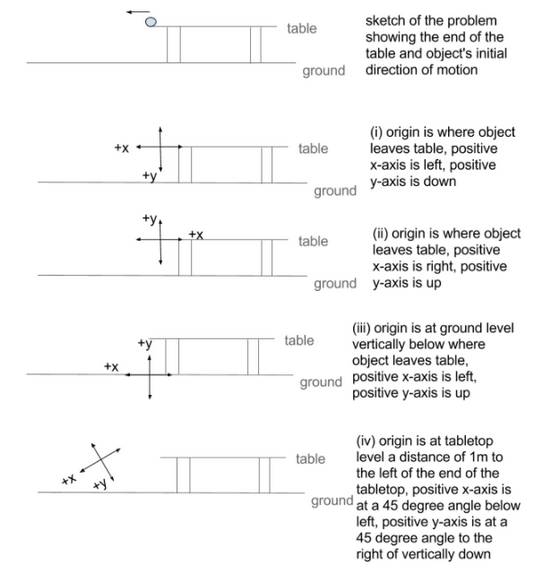
Imagine you are doing a problem in which a ball is shot horizontally off a table. In this problem, you are not given a coordinate system in the problem statement. Select all answers that show a choice of the coordinate system which could be used to do this problem (and get a correct answer).
i
ii
iii
iv
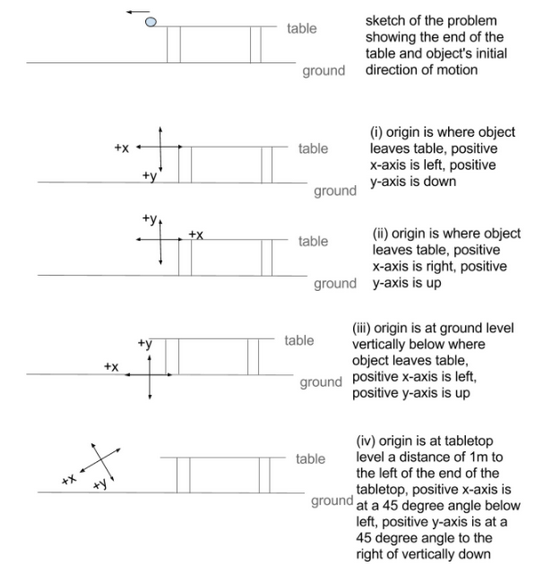
Consider the object at the time shown in the first image. How does the position vector at this time differ between coordinate systems (i) and (iii)?
The position vector would look different if you were to draw it on the page, and it would have different mathematical coordinates in the two coordinate systems.
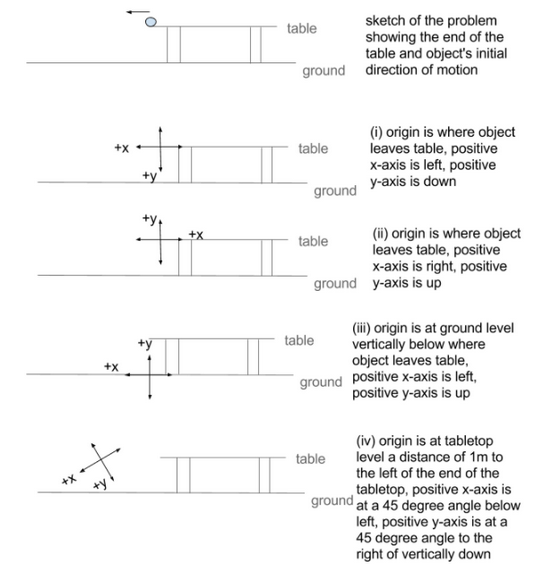
Consider the object at the time shown in the first image. How does the position vector at this time differ between coordinate systems (i) and (ii)?
The position vector would look the same if you were to draw it on the page, but it would have different mathematical coordinates in the two coordinate systems.

The displacement vector is the change in the position vector (Positionf - Positioni). Consider the displacement vector between the two times shown. Does the arrow you draw to represent the displacement vector between these two times depend on the choice of coordinate system? Do the coordinates of the displacement vector depend on the choice of coordinate system? ((You can use the position vectors you determined in the previous problems to actually do this and prove the answer to yourself.)
The displacement vector you draw does not depend on the choice of coordinate system, but the coordinates of the displacement vector do depend on the choice of coordinate system.
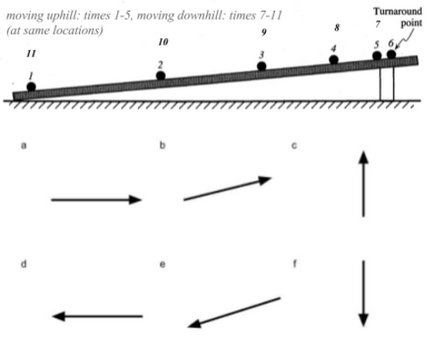
An object moves up, then down an inclined ramp. The times for the object moving up are 1-5, 6 is the top of the object's trajectory, and 7-11 are the object moving down the ramp. Consider the time when the ball is at location 2. Which of the above vectors matches the direction of the velocity?
B
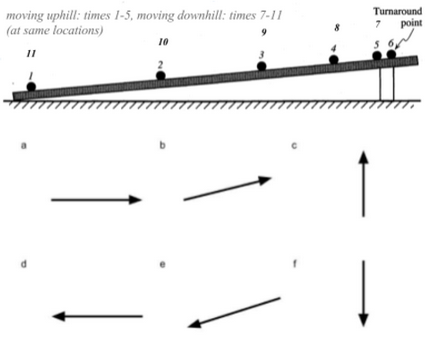
Consider the time when the ball is at location 2. Which of the above vectors matches the direction of the acceleration?
E
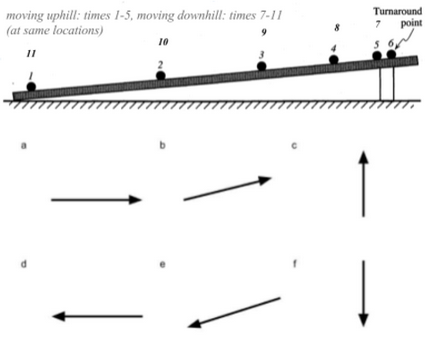
Use the description and vectors shown above. Consider the time when the ball is at location 6. Which of the above vectors matches the direction of the velocity?
It is zero
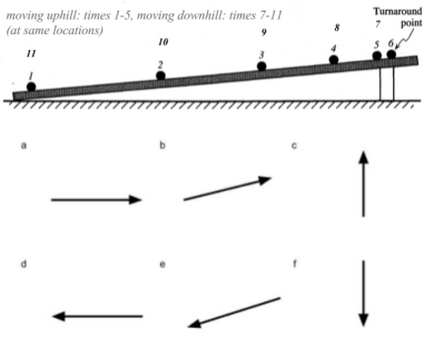
Consider the time when the ball is at location 6. Which of the above vectors matches the direction of the acceleration?
E
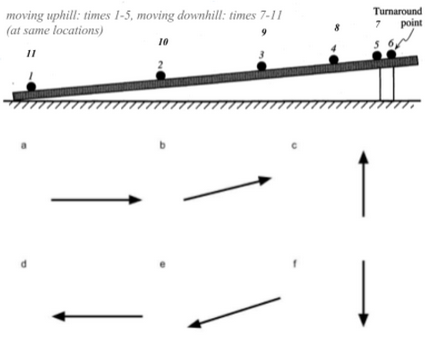
Consider the time when the ball is at location 10. Which of the above vectors matches the direction of the velocity?
E
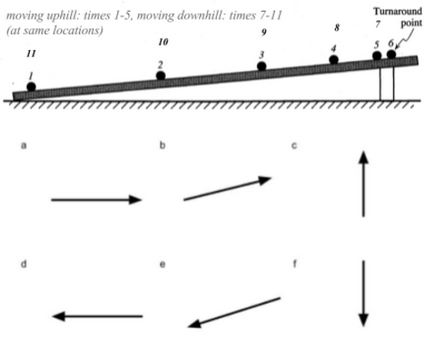
Consider the time when the ball is at location 10. Which of the above vectors matches the direction of the acceleration?
E
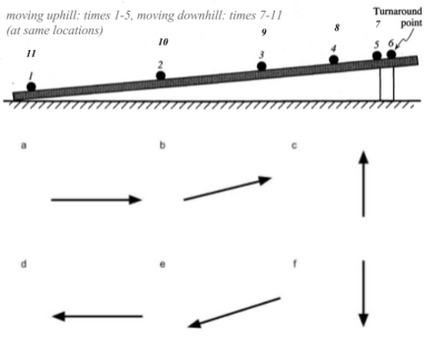
How does the magnitude of the velocity vector change between times 1 and 5?
Decreases
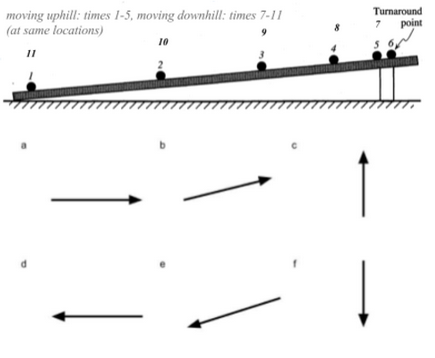
How does the magnitude of the velocity vector change between times 7 and 11?
Increases
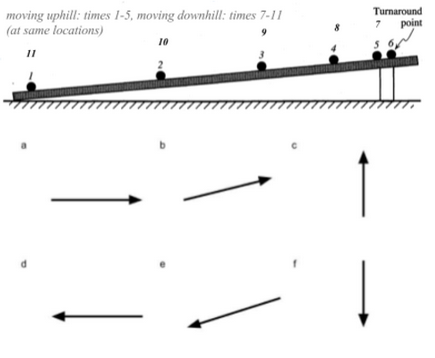
Compare the directions of the velocity and acceleration vectors at time 4.
They point in opposite directions
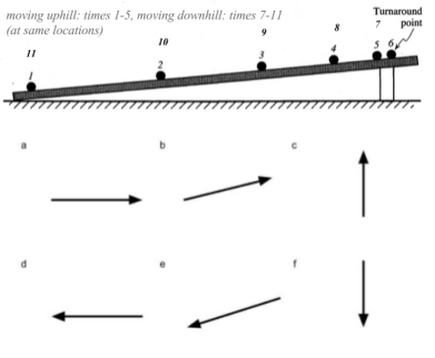
Compare the directions of the velocity and acceleration vectors at time 10.
They point in the same direction
If at some point in time an object has zero velocity and zero acceleration, what does that mean about its motion at the next instant?
The object will remain in the same location and will not begin to move.
Gravitational forces are due to:
Objects with mass attracting one another
Normal forces are due to:
The contact between two surfaces
The direction of a normal force:
Is perpendicular to the surface of the object exerting the force.
Weight is:
A force
Which forces belong on a free-body diagram of a car?
Forces exerted on the car by other objects
When drawing a free-body diagram, how should vectors be drawn?
With their tails on the object
Fill in the blanks to the statement below in the next three questions:
A train composed of a small engine car and a massive cargo car are connected as they move along a track. The speed of the small engine car is __1__ the speed of the massive cargo car. The magnitude of the acceleration of the small engine car is __2__ the magnitude of the acceleration of the massive cargo car because __3__ .
1: Equal to
2: Equal to
3: The car’s speeds cannot change by different amounts.

Which force(s) listed below exert a force on Pam as she moves to the right?
The force of the block on Pam
The force of the rope on Pam
The motion force (due to Pam’s motion to the right)
The force of the rope on Pam

A student draws the free body diagram shown below. Based on this diagram, the net force on the object:
Is to the right
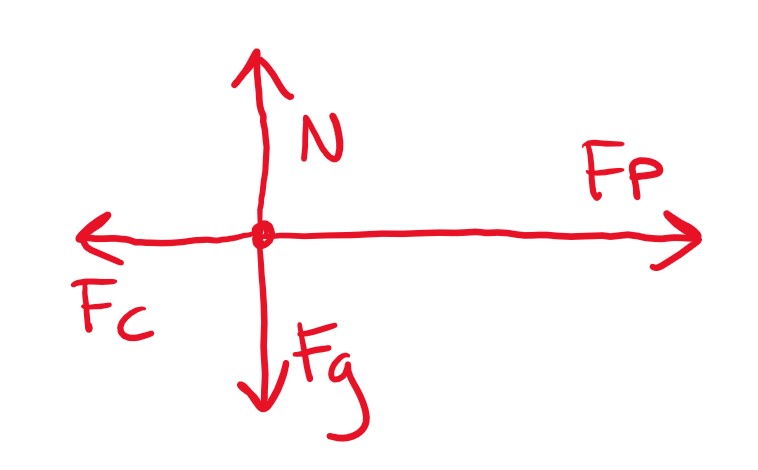
Based on this diagram, the acceleration of the object:
Is to the right

Consider the following 3 pieces of the motion for a block that is initially at rest on a floor. (1) The block's velocity is zero at the instant it is given a quick push by a hand. (2) The hand does not touch the block after the quick push. The block slides across the floor, gradually slows down, then comes to rest. In (3), the block is at rest.
In (1), while the hand is pushing the block, but while the block still has zero velocity, what is the direction of the net force on the block?
To the right
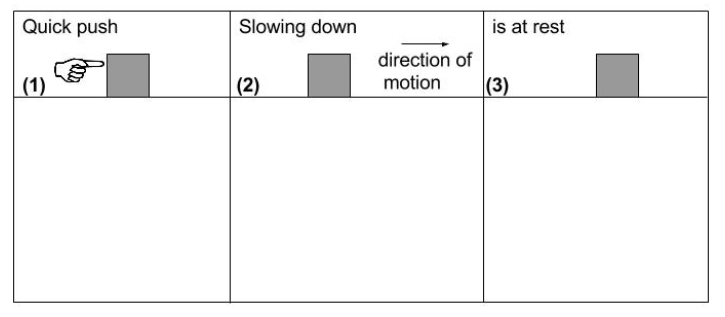
Consider the following 3 pieces of the motion for a block that is initially at rest on a floor. (1) The block's velocity is zero at the instant it is given a quick push by a hand. (2) The hand does not touch the block after the quick push. The block slides across the floor, gradually slows down, then comes to rest. In (3), the block is at rest.
In (2), after the hand has let go but while the block moves, what is the direction of the net force on the block?
To the left

Consider the following 3 pieces of the motion for a block that is initially at rest on a floor. (1) The block's velocity is zero at the instant it is given a quick push by a hand. (2) The hand does not touch the block after the quick push. The block slides across the floor, gradually slows down, then comes to rest. In (3), the block is at rest.
In (3), after the block has stopped moving and is at rest, what is the direction of the net force on the block?
Zero (no direction)
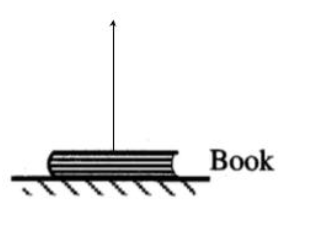
Now consider the case where, instead of a hand pushing down, a string is pulling up on the book. The book is still lying on a table, in full contact with the table, and not moving. Which of the forces do you include on the free body diagram of the book?
Normal force of table on the book
Normal force of book on table
Normal force of hand on book
Normal force of book on hand
Tension of string on book
Tension of book on string
Weight of book
Weight of table
Force of gravity of the book on the earth
Normal force of table on book
Tension of string on book
Weight of book
Consider these two cases for the following two questions: (1) a book sits at rest on a table, touching only the table, and (2) a string pulls up on a book which is at rest on a table.
The magnitude of the normal force of the table on the book in (1) is _______ the magnitude of the normal force of the table on the book in (2).
Greater than
Consider these two cases for the following two questions: (1) a book sits at rest on a table, touching only the table, and (2) a string pulls up on a book which is at rest on a table.
The direction of the normal force of the table on the book in (1) is in the _______ direction as the normal force of the table on the book in (2).
Same
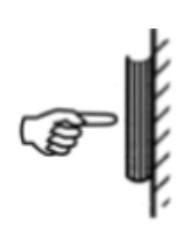
A hand pushes a book against a wall. Both the book and the hand are at rest. Select two forces in this situation which are a third-law pair.
The normal force of the book on your hand
The normal force of the wall on the book
The normal force of the book on the wall
The weight of the book
The force of friction on the book
The normal force of the wall on the book
The normal force of the book on the wall
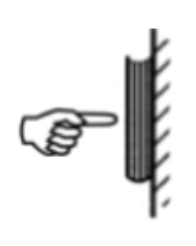
A hand pushes a book against a wall. Both the book and the hand are at rest.
Are these forces a third-law pair? Force of friction of the table on the book, and normal force of the book on the table
No
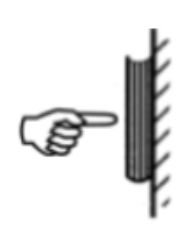
A hand pushes a book against a wall. Both the book and the hand are at rest.
Are these forces a third-law pair? Normal force of the hand on the wall, and normal force of the wall on the hand
Yes
Tension force is the force between:
Adjacent pieces of a rope
A rope and an object attached to the end of a rope
Pick the best answer for the following: tension force _____________.
Pulls along a rope
Pulls perpendicular to a rope
Has one component along a rope and one component perpendicular to the rope
Pulls along a rope
Tension force has units of ________. Check all that apply.
kg
m/s
N
m/s2
kg*m/s2
Tesla (T)
N
kg*m/s²
Which of the following statements are true about a massless rope:
With a massless rope, the tension at the end of the rope is larger than the tension in the center of the rope.
With a massless rope, the tension in the center of the rope is larger than the tension at the ends of the rope.
With a massless rope, the tension at one end of a rope can be different than the tension at the other end of the rope.
With a massless rope, the tension in the center of the rope is the same as the tension at the end of the rope.
With a massless rope, the tension in the center of the rope is the same as the tension at the end of the rope.
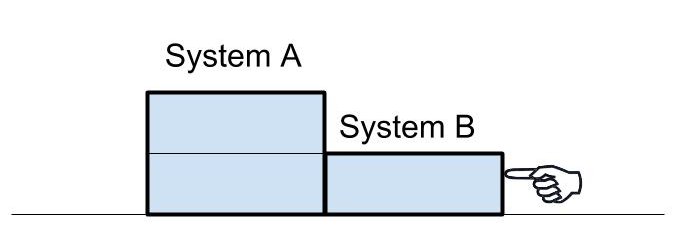
A hand pushes three identical bricks as shown. The bricks are moving to the left and speeding up. System A consists of two bricks stacked together. System B consists of a single brick. System C consists of all three bricks. There is friction between the bricks and the table.
Which forces would be included in the free body diagrams for system A?
Force of friction on system A directed left
Force of friction on system A directed right
Force of friction on system B directed left
Force of friction on system B directed right
Force of friction on system C directed left
Force of friction on system C directed right
Force of system B on system A
Force of system A on system B
The normal force of the table on system A
The normal force of the table on system C
The force of gravity on system A
The force of gravity on system C
The force of the hand on system A
The force of the hand on system C
The force of motion on system A
The force of motion on system C
Force of friction on system A directed right
Force of system B on system A
The normal force of the table on system A
The force of gravity on system A
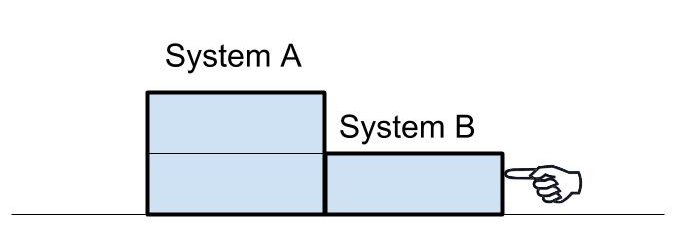
A hand pushes three identical bricks as shown. The bricks are moving to the left and speeding up. System A consists of two bricks stacked together. System B consists of a single brick. System C consists of all three bricks. There is friction between the bricks and the table.
Which forces would be included in the free body diagrams for system C?
Force of friction on system A directed left
Force of friction on system A directed right
Force of friction on system B directed left
Force of friction on system B directed right
Force of friction on system C directed left
Force of friction on system C directed right
Force of system B on system A
Force of system A on system B
The normal force of the table on system A
The normal force of the table on system C
The force of gravity on system A
The force of gravity on system C
The force of the hand on system A
The force of the hand on system C
The force of motion on system A
The force of motion on system C
Force of friction on system C directed right
The normal force of the table on system C
The force of gravity on system C
The force of the hand on system C
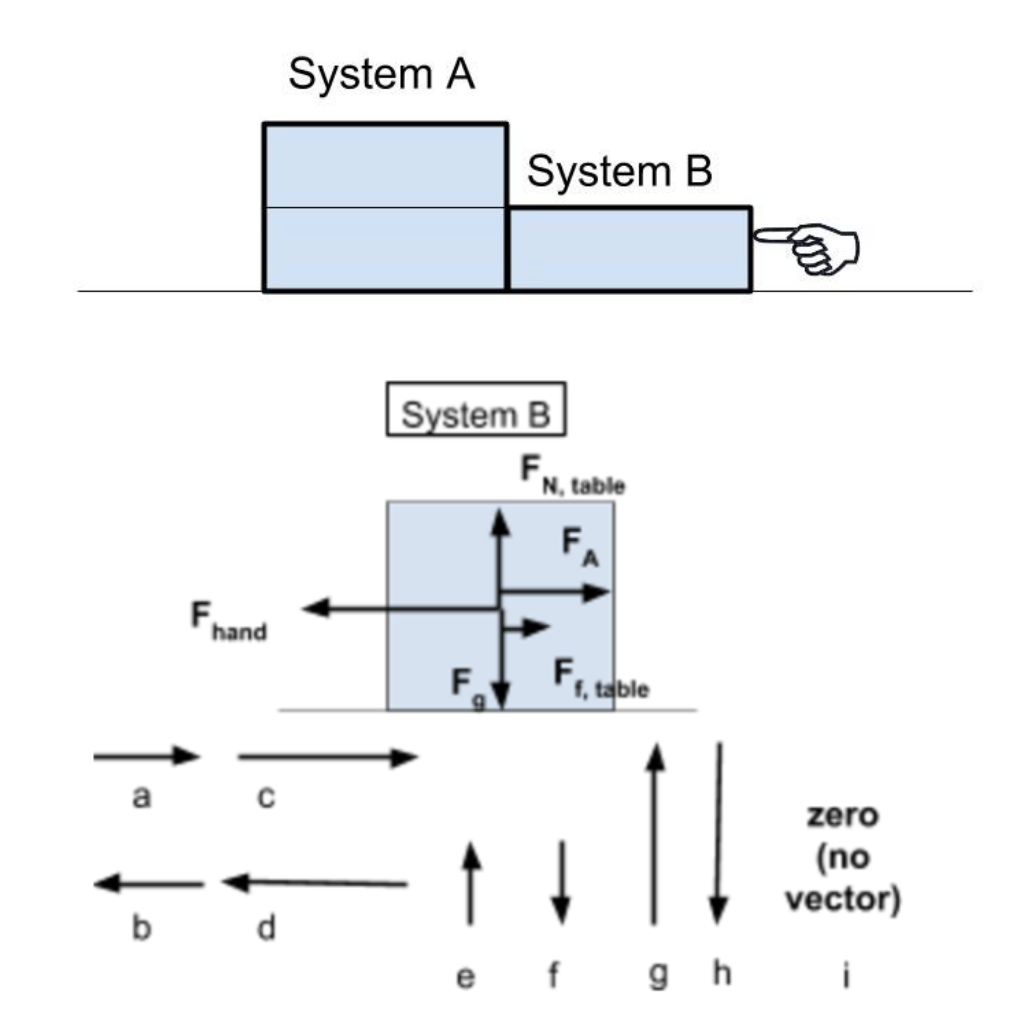
Continue to consider the situation with systems A and B, and the hand. Below is a free body diagram for system B. Given this information, fill in the best vector (considering both length and direction using the scale in the free body diagram for B) for each force described in the following questions. Note that the force diagram is provided for system B and asks you to infer what you know based on that information and the situation described above to describe forces (both length and direction) on system A.
What is the force of system B on system A?
B
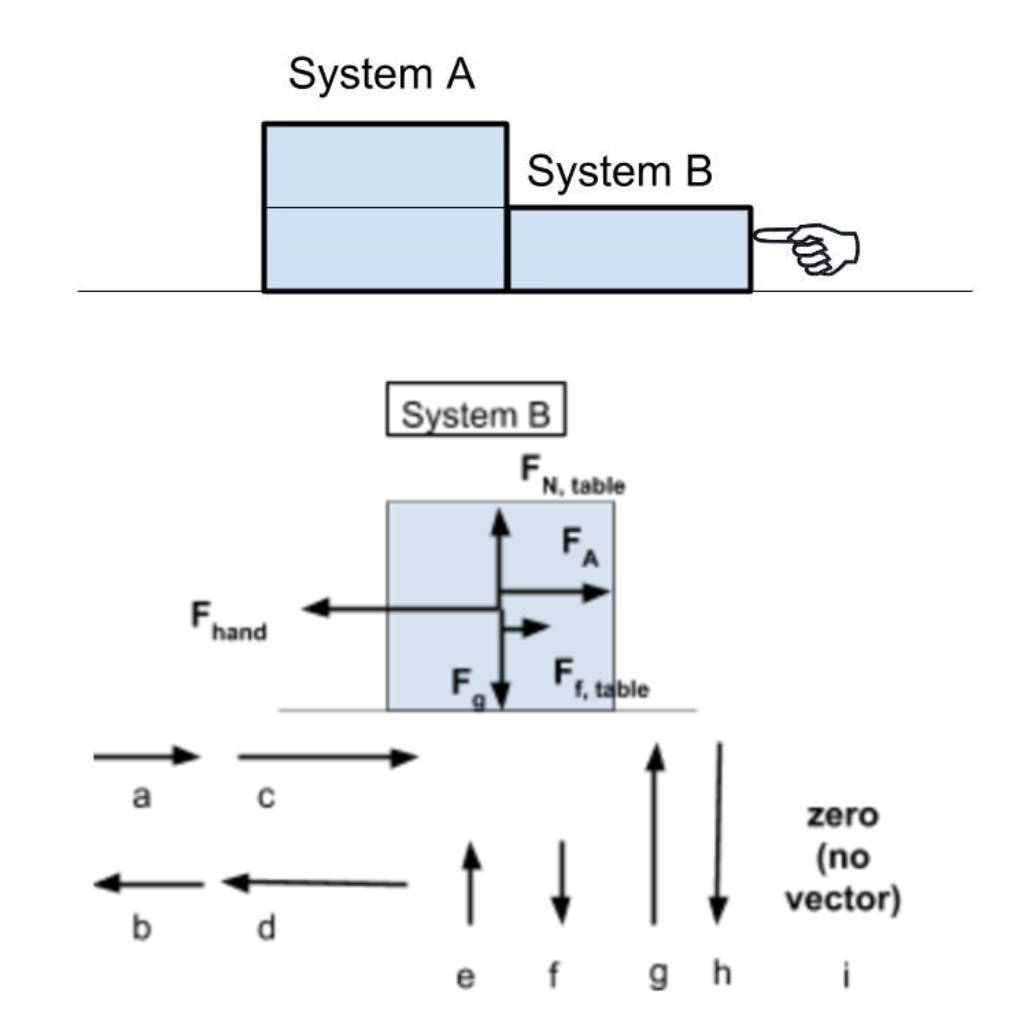
Continue to consider the situation with systems A and B, and the hand. Below is a free body diagram for system B. Given this information, fill in the best vector (considering both length and direction using the scale in the free body diagram for B) for each force described in the following questions. Note that the force diagram is provided for system B and asks you to infer what you know based on that information and the situation described above to describe forces (both length and direction) on system A.
What is the normal force of the table on system A?
G

Continue to consider the situation with systems A and B, and the hand. Below is a free body diagram for system B. Given this information, fill in the best vector (considering both length and direction using the scale in the free body diagram for B) for each force described in the following questions. Note that the force diagram is provided for system B and asks you to infer what you know based on that information and the situation described above to describe forces (both length and direction) on system A.
What is the force of the hand on system A?
i
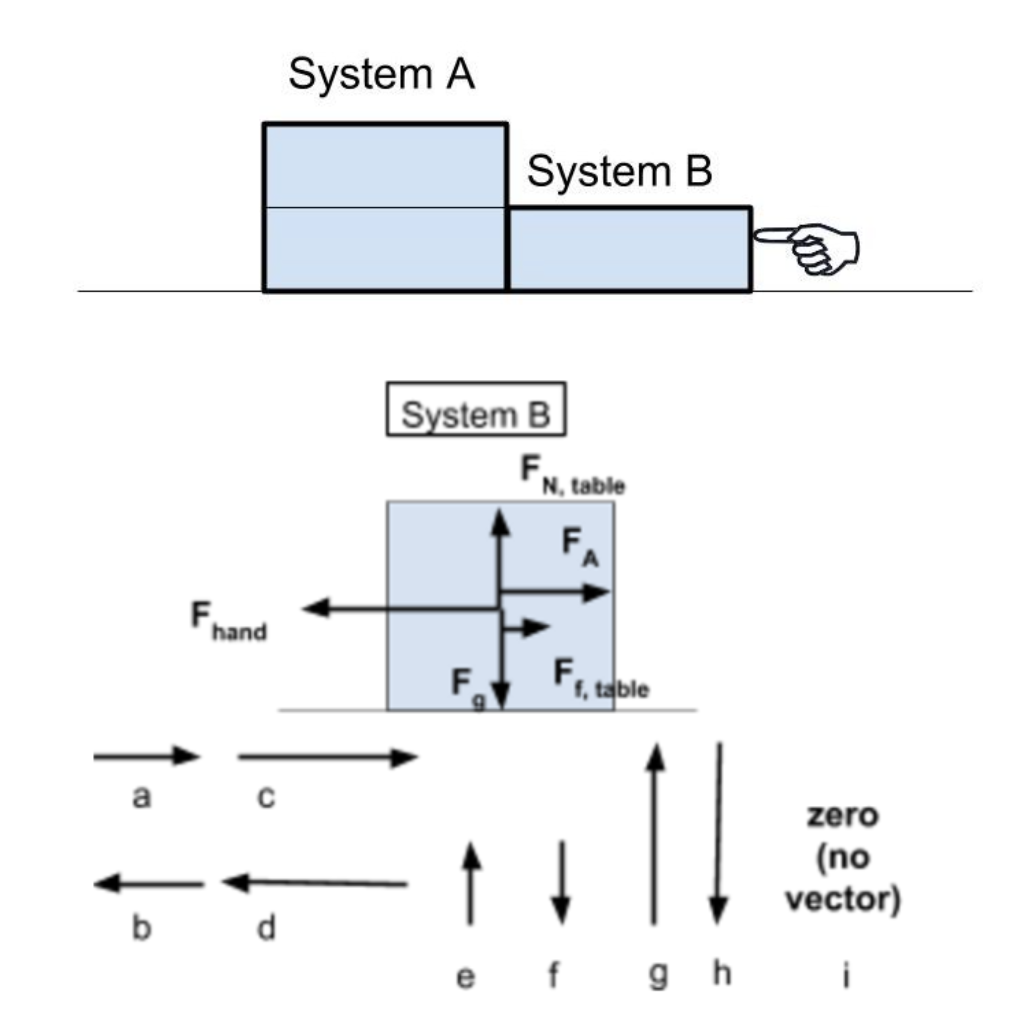
Continue to consider the situation with systems A and B, and the hand. Below is a free body diagram for system B. Given this information, fill in the best vector (considering both length and direction using the scale in the free body diagram for B) for each force described in the following questions. Note that the force diagram is provided for system B and asks you to infer what you know based on that information and the situation described above to describe forces (both length and direction) on system A.
What is the force of the hand on system C?
D
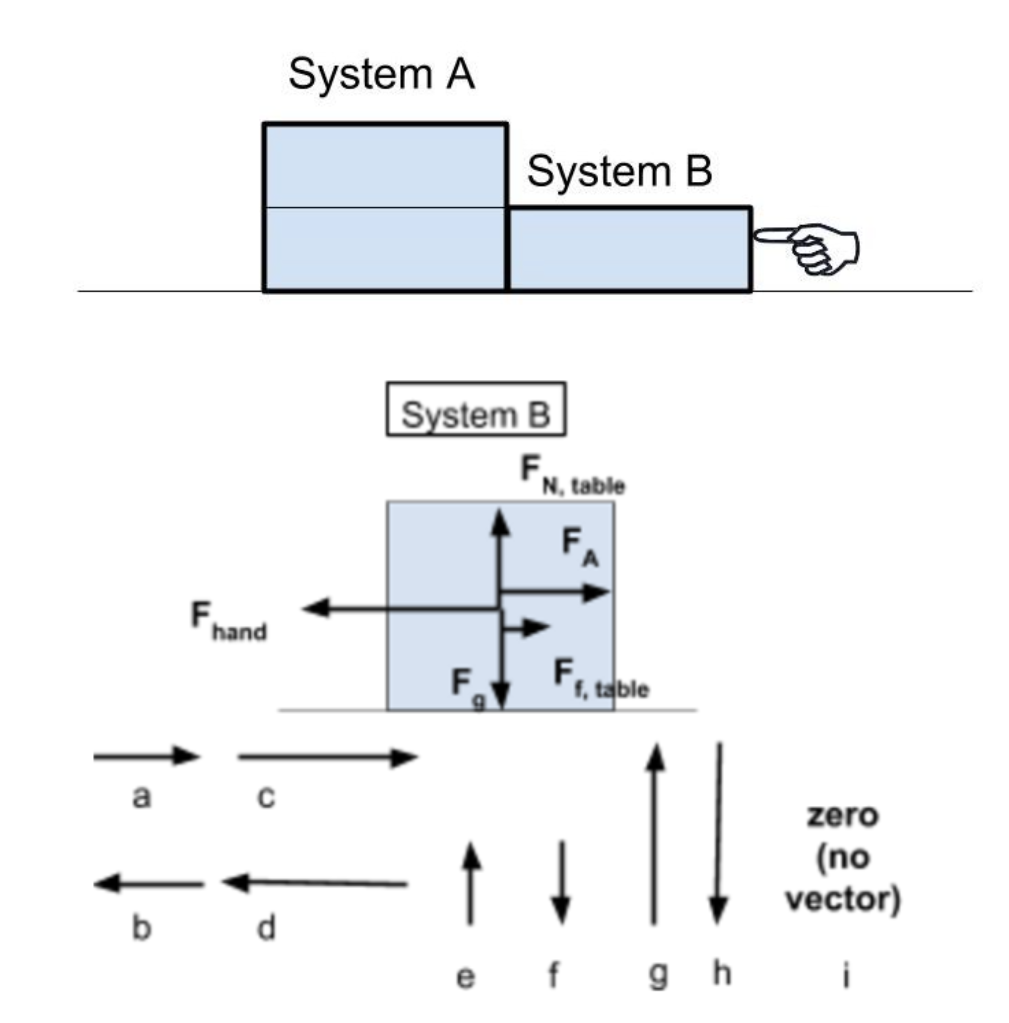
With regards to the system, which of the following statements is true about the magnitude of the acceleration of systems A, B, and C?
They all have equal magnitudes of acceleration
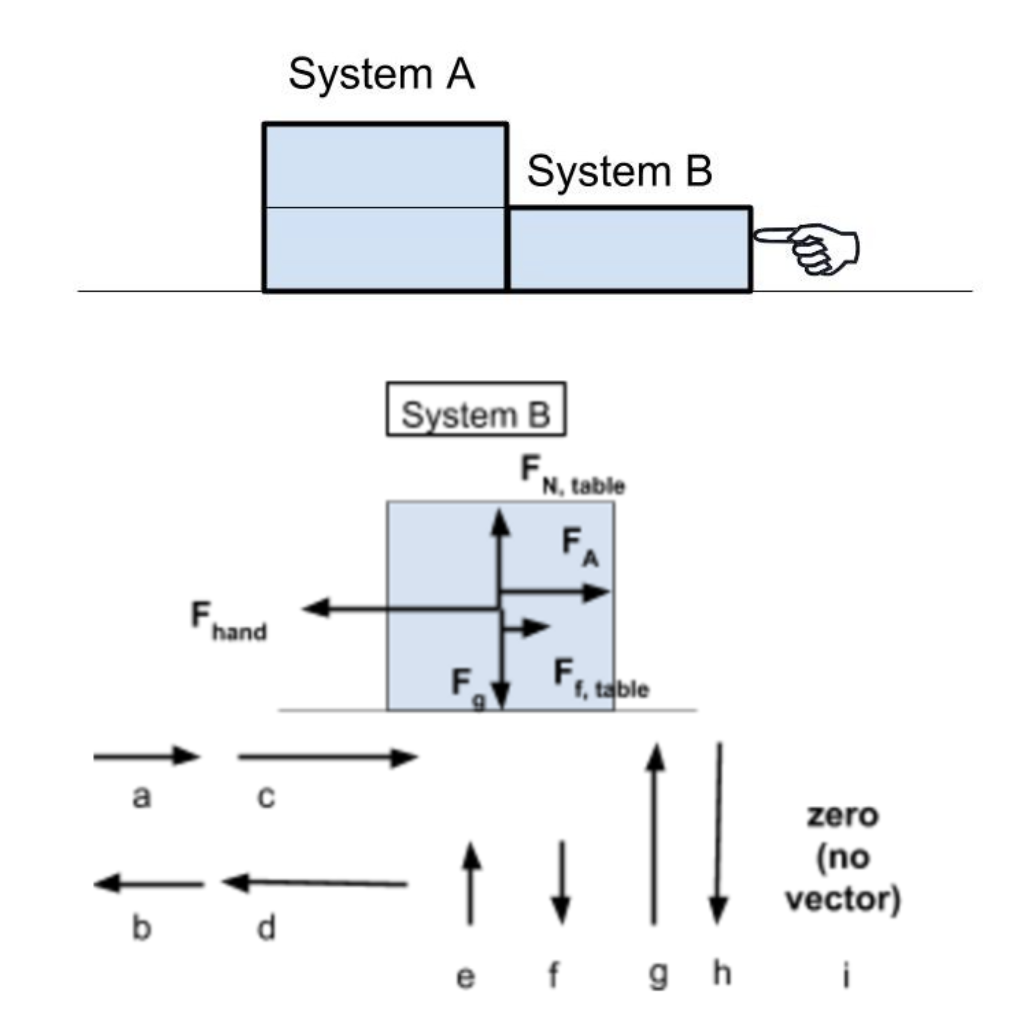
Which of the following statements is true about the magnitude of the net force on systems A, B, and C?
System C has the largest magnitude of net force.
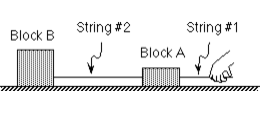
The following questions use the same geometry. Two blocks of unequal mass (mA < mB) are connected by a string (string 2). The blocks are placed on a table and pulled by another string (string 1) that is attached to block A such that both blocks move together. Assume both strings are inextensible (do not stretch or become slack) and massless.
Answer the following questions assuming the hand pulls the blocks to the right with a constant nonzero force and the blocks move at constant speed to the right.
Fill in the blank: It ____ the table to be frictionless.
is not possible for
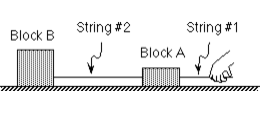
The following questions use the same geometry. Two blocks of unequal mass (mA < mB) are connected by a string (string 2). The blocks are placed on a table and pulled by another string (string 1) that is attached to block A such that both blocks move together. Assume both strings are inextensible (do not stretch or become slack) and massless.
Answer the following questions assuming the hand pulls the blocks to the right with a constant force and the blocks move at constant speed to the right.
Fill in the blank: The magnitude of the velocity of block A is _____ to magnitude of the velocity of block B.
Equal to
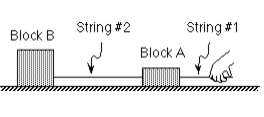
The following questions use the same geometry. Two blocks of unequal mass (mA < mB) are connected by a string (string 2). The blocks are placed on a table and pulled by another string (string 1) that is attached to block A such that both blocks move together. Assume both strings are inextensible (do not stretch or become slack) and massless.
Answer the following questions assuming the hand pulls the blocks to the right with a constant force and the blocks move at constant speed to the right.
Fill in the blank: The magnitude of the acceleration of block A is ______ to magnitude of the acceleration of block B.
Equal to
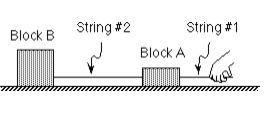
The following questions use the same geometry. Two blocks of unequal mass (mA < mB) are connected by a string (string 2). The blocks are placed on a table and pulled by another string (string 1) that is attached to block A such that both blocks move together. Assume both strings are inextensible (do not stretch or become slack) and massless.
Answer the following questions assuming the hand pulls the blocks to the right with a constant force and the blocks move at constant speed to the right.
Fill in the blank: The magnitude of the force on A by string 1 is __1__ to the magnitude of the force on string 1 by A. The physical idea that best justifies this is __2__
1: Equal to
2: Newton’s Third Law
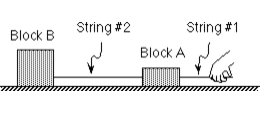
The following questions use the same geometry. Two blocks of unequal mass (mA < mB) are connected by a string (string 2). The blocks are placed on a table and pulled by another string (string 1) that is attached to block A such that both blocks move together. Assume both strings are inextensible (do not stretch or become slack) and massless.
Answer the following questions assuming the hand pulls the blocks to the right with a constant force and the blocks move at constant speed to the right.
Fill in the blank: The magnitude of the force on A by string 1 is __1__ to the magnitude of the force on string 2 by A. The physical idea that best justifies this is __2__
1: Greater than
2: Newton’s Second Law
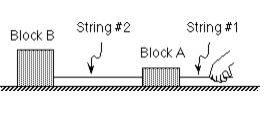
Two blocks of unequal mass (mA < mB) are connected by a string (string 2). The blocks are placed on a table and pulled by another string (string 1) that is attached to block A such that both blocks move together. Assume both strings are inextensible (do not stretch or become slack) and massless.
Answer the following questions assuming the hand pulls the blocks to the right with a force that decreases in magnitude (but always points to the right) and the table is frictionless.
Fill in the blank: The magnitude of the velocity of block A is ____ to magnitude of the velocity of block B.
Equal to
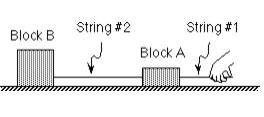
Two blocks of unequal mass (mA < mB) are connected by a string (string 2). The blocks are placed on a table and pulled by another string (string 1) that is attached to block A such that both blocks move together. Assume both strings are inextensible (do not stretch or become slack) and massless.
Answer the following questions assuming the hand pulls the blocks to the right with a force that decreases in magnitude (but always points to the right) and the table is frictionless.
Fill in the blank: The magnitude of the acceleration of block A is ____ to magnitude of the acceleration of block B.
Equal to
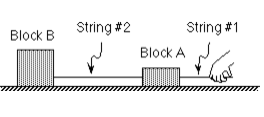
Two blocks of unequal mass (mA < mB) are connected by a string (string 2). The blocks are placed on a table and pulled by another string (string 1) that is attached to block A such that both blocks move together. Assume both strings are inextensible (do not stretch or become slack) and massless.
Answer the following questions assuming the hand pulls the blocks to the right with a force that decreases in magnitude (but always points to the right) and the table is frictionless.
Fill in the blank: The magnitude of the force on A by string 1 is __1__ to the magnitude of the force on string 1 by A. The physical idea that best justifies this is __2__.
1: Equal to
2: Newton’s Third Law
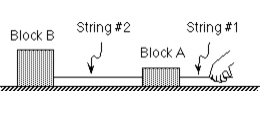
Two blocks of unequal mass (mA < mB) are connected by a string (string 2). The blocks are placed on a table and pulled by another string (string 1) that is attached to block A such that both blocks move together. Assume both strings are inextensible (do not stretch or become slack) and massless.
Answer the following questions assuming the hand pulls the blocks to the right with a force that decreases in magnitude (but always points to the right) and the table is frictionless.
Fill in the blank: The magnitude of the force on A by string 1 is __1__ to the magnitude of the force on A by string 2. The physical idea that best justifies this is __2__
1: Greater than
2: Newton’s Second Law
How do the base units of energy compare to the base units of work? Hint: use dimensional analysis using a fundamental principle such as the definition of work to determine units.
Same base units
Imagine a system with a certain amount of kinetic energy. Which of the following systems would have a larger kinetic energy?
A system with more mass but the same speed
A system with less mass but the same speed
A system with the same mass but greater speed
A system with the same mass but smaller speed
A system with more mass but the same speed
A system with the same mass but greater speed
A system is defined as:
A collection of objects
True or false: There is only one possible choice of system which could be correct when doing problems using work and energy.
False
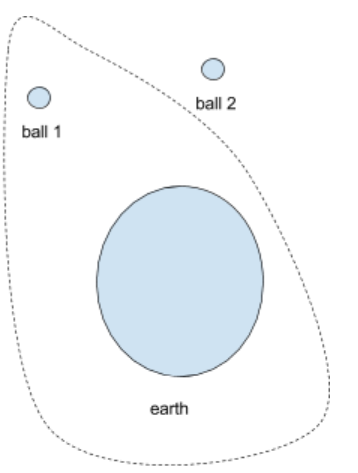
Consider the choice of system shown in the image. Which of the following forces is/are internal to the system?
the gravitational force of ball 1 on the earth
the gravitation force of the earth on ball 1
the gravitational force of ball 2 on the earth
the gravitation force of the earth on ball 2
any contact forces ball 1 exerts on ball 2
any contact forces ball 2 exerts on ball 1
any gravitational forces ball 1 exerts on ball 2
any gravitational forces ball 2 exerts on ball 1
the gravitational force of ball 1 on the earth
the gravitation force of the earth on ball 1
True or False: Work is a vector.
False
True or false: It is possible to calculate the work done and get a negative answer.
True
True or false: The law of conservation of energy says that the total amount of energy in the universe cannot change.
True
True or false: The law of conservation of energy says that the total amount of energy of a system cannot change.
False
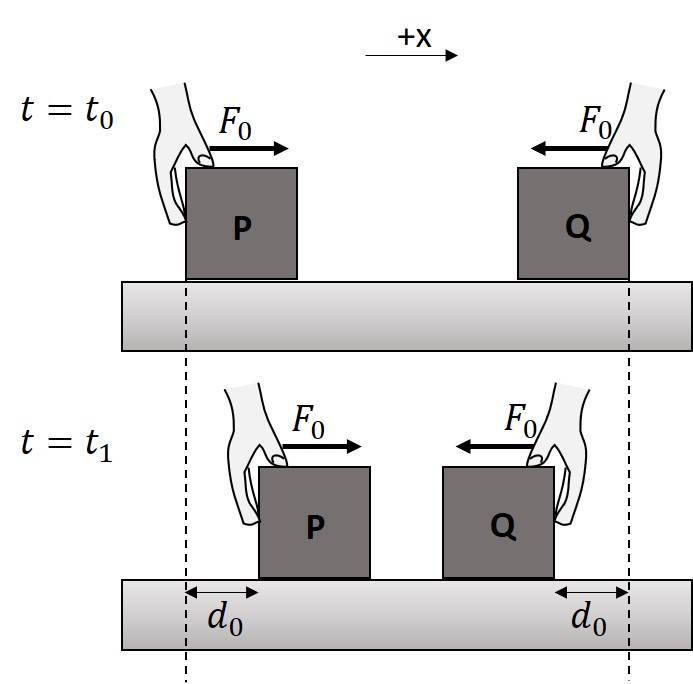
Two identical blocks, P and Q, are at rest on a flat, frictionless table. P is pushed by a hand exerting a constant force of magnitude F0 to the right, and Q is pushed by a hand exerting a constant force of magnitude F0 to the left. At time t = t1, each block has moved a distance d0 from its initial position, as shown below. Answer the following questions based on this setup.
The work done by the hand on P ___(i)____ BECAUSE the force of the hand is ___(ii)____.
(i) is positive, (ii) in the positive x-direction
(i) is positive, (ii) in the negative x-direction
(i) is positive, (ii) in the same direction as the block's displacement
(i) is positive, (ii) in the opposite direction as the block's displacement
(i) is negative, (ii) in the positive x-direction
(i) is negative, (ii) in the negative x-direction
(i) is negative, (ii) in the same direction as the block's displacement
(i) is negative, (ii) in the opposite direction as the block's displacement
(i) is zero, (ii) in the positive x-direction
(i) is zero, (ii) in the negative x-direction
(i) is zero, (ii) in the same direction as the block's displacement
(i) is zero, (ii) in the opposite direction as the block's displacement
(i) cannot be determined, (ii) (it cannot be determined)
(i) is positive, (ii) in the same direction as the block's displacement
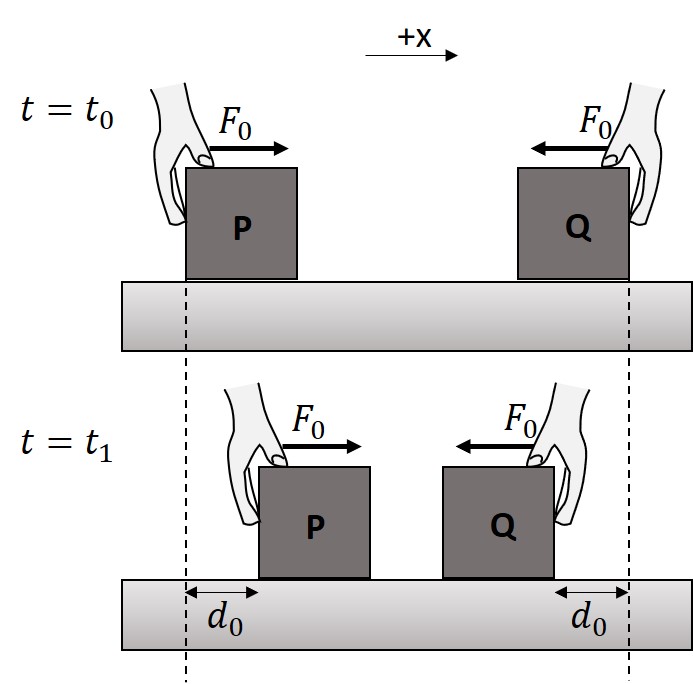
Two identical blocks, P and Q, are at rest on a flat, frictionless table. P is pushed by a hand exerting a constant force of magnitude F0 to the right, and Q is pushed by a hand exerting a constant force of magnitude F0 to the left. At time t = t1, each block has moved a distance d0 from its initial position, as shown below. Answer the following questions based on this setup.
The work done by the hand on Q ___(i)____ BECAUSE the force of the hand is ___(ii)____.
(i) is positive, (ii) in the positive x-direction
(i) is positive, (ii) in the negative x-direction
(i) is positive, (ii) in the same direction as the block's displacement
(i) is positive, (ii) in the opposite direction as the block's displacement
(i) is negative, (ii) in the positive x-direction
(i) is negative, (ii) in the negative x-direction
(i) is negative, (ii) in the same direction as the block's displacement
(i) is negative, (ii) in the opposite direction as the block's displacement
(i) is zero, (ii) in the positive x-direction
(i) is zero, (ii) in the negative x-direction
(i) is zero, (ii) in the same direction as the block's displacement
(i) is zero, (ii) in the opposite direction as the block's displacement
(i) cannot be determined, (ii) (it cannot be determined)
(i) is positive, (ii) in the same direction as the block's displacement
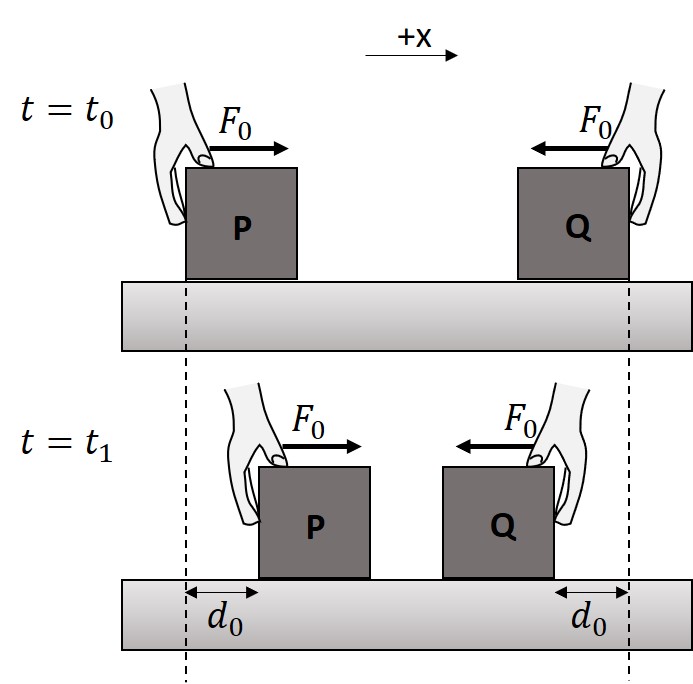
Two identical blocks, P and Q, are at rest on a flat, frictionless table. P is pushed by a hand exerting a constant force of magnitude F0 to the right, and Q is pushed by a hand exerting a constant force of magnitude F0 to the left. At time t = t1, each block has moved a distance d0 from its initial position, as shown below. Answer the following questions based on this setup.
If there is no friction, then as it is being pushed, Q’s kinetic energy:
Increases
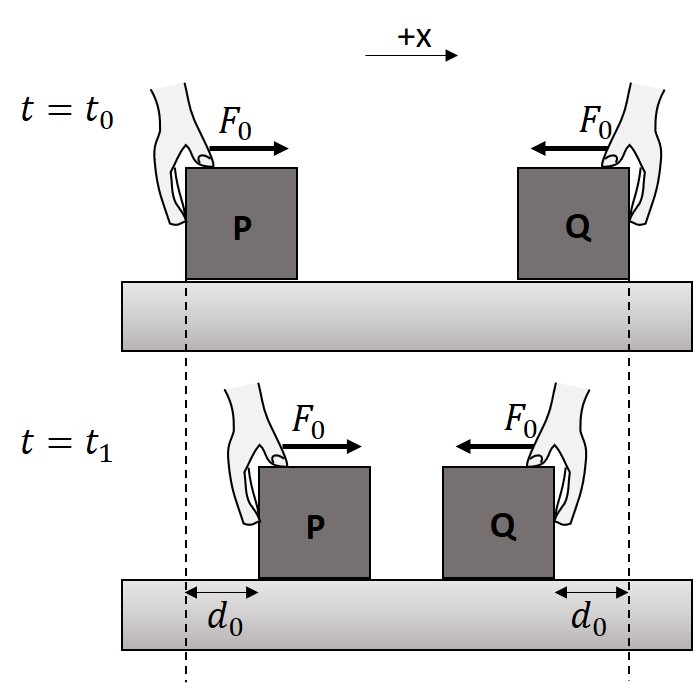
Two identical blocks, P and Q, are at rest on a flat, frictionless table. P is pushed by a hand exerting a constant force of magnitude F0 to the right, and Q is pushed by a hand exerting a constant force of magnitude F0 to the left. At time t = t1, each block has moved a distance d0 from its initial position, as shown below. Answer the following questions based on this setup.
Is it possible for Q’s kinetic energy to increase as it is being pushed if there is kinetic friction with the surface?
Yes
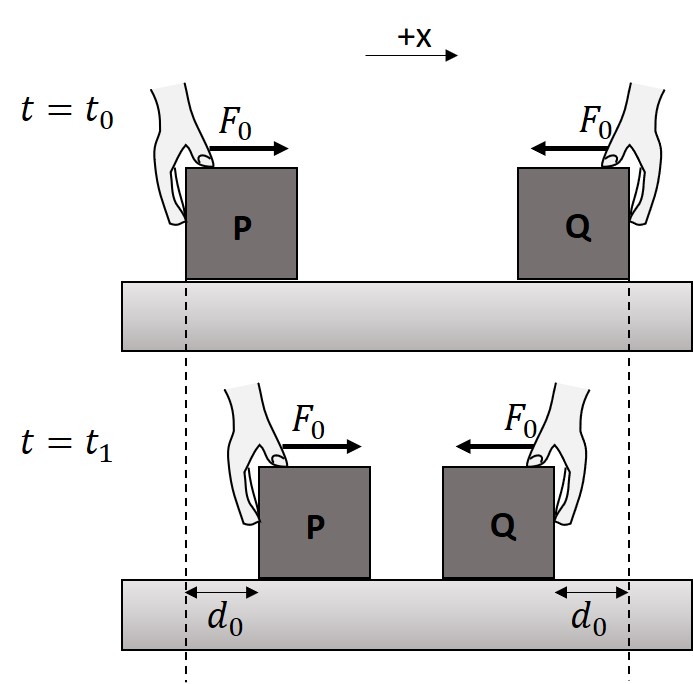
Two identical blocks, P and Q, are at rest on a flat, frictionless table. P is pushed by a hand exerting a constant force of magnitude F0 to the right, and Q is pushed by a hand exerting a constant force of magnitude F0 to the left. At time t = t1, each block has moved a distance d0 from its initial position, as shown below. Answer the following questions based on this setup.
Kinetic energy is a ___(i)___. It is ___(ii)___ for kinetic energy to have a negative value.
scalar, possible
scalar, not possible
vector, possible
vector, not possible
scalar, not possible
Work is a
scalar
Consider two cases: one in which work done on an object is +5J and one in which work done on an object is -5J. Which of the following statements are true?
The direction of work is opposite in the two cases
Work does not have direction
Work does not have direction
Imagine two cases: Block N is pushed by a hand, which exerts a constant force F0. N moves a distance d0. In case 1, it takes a time T to move this distance. In a case 2, it takes time 2T to move this distance.
The work done by the hand on N in case 1 is ____________ the work done by the hand in case 2.
Equal to
The net work on N in case 1 is _______________ the net work done on N in case 2. Hint: consider why case 2 takes longer.
Greater than

A hand pushes a box with the same purely horizontal force in two cases. In case 1, the box moves a distance d_0 across a horizontal, frictionless surface. In case 2, the box moves a distance d_0 up a frictionless ramp. The work done by the hand on the box in case 1 (horizontal motion) ________ the work done by the hand on the box in case 2 (motion along incline).
is greater than
A weightlifter holds a barbell motionless at her chest as she prepares to lift it over her head. The work done by the weightlifter to hold the barbell in this position is ________________.
Zero
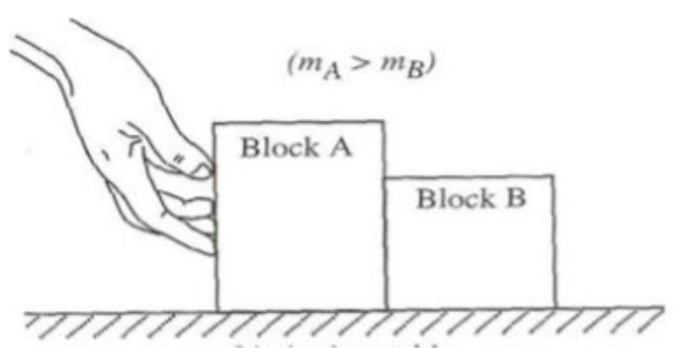
A hand pushes two blocks, block A and block B, along a table for a distance d. There is friction. The mass of block A is greater than the mass of block B (m_A>m_B). The blocks are moving with a constant velocity.
The magnitude of the net force on block A is __________ the net force on block B.
Equal to
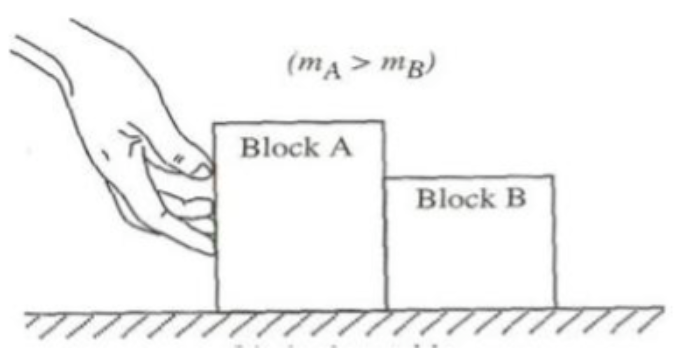
A hand pushes two blocks, block A and block B, along a table for a distance d. There is friction. The mass of block A is greater than the mass of block B (m_A>m_B). The blocks are moving with a constant velocity.
The final speed of block A is __________ the final speed of block B.
Equal to
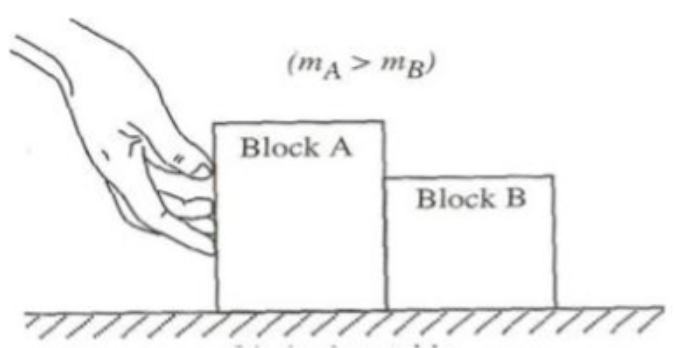
A hand pushes two blocks, block A and block B, along a table for a distance d. There is friction. The mass of block A is greater than the mass of block B (m_A>m_B). The blocks are moving with a constant velocity.
The final kinetic energy of block A is __________ the final kinetic energy of block B.
Greater than
Assume no heat is exchanged in the following scenario (Q=0). If the work done on an object by external forces is zero, the CHANGE in total energy of the object
Is zero
Assume no heat is exchanged in the following scenario (Q=0). If the work done on an object by external forces is positive, the CHANGE in total energy of the object
Is positive
Assume no heat is exchanged in the following scenario (Q=0). If the work done on an object by external forces is negative, the CHANGE in total energy of the object
Is negative
Assume no heat is exchanged in the following scenario (Q=0). The work done on an object by external forces 5J. The TOTAL ENERGY of the system
Cannot be determined without additional information
“Stored” energy is referred to as
Potential energy
How is "stored energy" stored?
In the location of objects relative to one another
What things must be true about a force and a system for there to be a potential energy in the system due to the force?
The object of the force (thing feeling the force) is part of the system
The agent of the force (thing exerting the force) is part of the system
Object and agent are external to the system
Force must be conservative
Force must be nonconservative
The object of the force (thing feeling the force) is part of the system
The agent of the force (thing exerting the force) is part of the system
Force must be conservative
A child holds a ball of mass m a distance h above the ground. In which system(s) is the force of gravity on the ball an internal force to the system?
The system of just the ball.
The system of the earth and the ball together.
The system of the earth, the ball, and the child's hand.
The system of the earth, the ball, and the entire child.
The system of the earth and the ball together.
The system of the earth, the ball, and the child's hand.
The system of the earth, the ball, and the entire child.
A child holds a ball of mass m a distance h above the ground. Check all of the following statements that describe potential energy correctly in this case. (Assume potential energy is zero when the ball is on the ground.)
The ball alone has potential energy mgh.
The system of the earth and the ball together have potential energy mgh.
The system of the earth and the ball together have potential energy mgh.
What kinds of potential energy will you study in this course?
Gravitational
Heat
Enthalpy
Spring
Kinetic
Gravitational
Spring
Which of the following is the work-energy theorem?
W = F ∆x
∆Esystem = Wext, net + Q
Wext = ∆K
Wext = ∆K
Which of the following is/are the statement of the law of conservation of energy?
W = F ∆x
Esystem = Wext, net + Q
∆Esystem = Wext, net + Q
Wext = ∆K
∆Esystem = Wext, net + Q
Which of the following statements is true?
The work-energy theorem is a special case of the law of conservation of energy.
The law of conservation of energy is a special case of the work-energy theorem.
The work-energy theorem is a special case of the law of conservation of energy.
The work-energy theorem is derived for a system which consists of
any number of objects without internal potential energy.
any number of objects which may have internal potential energy.
a single object without internal potential energy.
a single object without internal potential energy.
The work-energy theorem _____ be applied to a system of two interacting objects.
Can
If we want to apply the work-energy theorem to a system, which kinds of energy in the system can change in amount?
Kinetic energy only

Point b
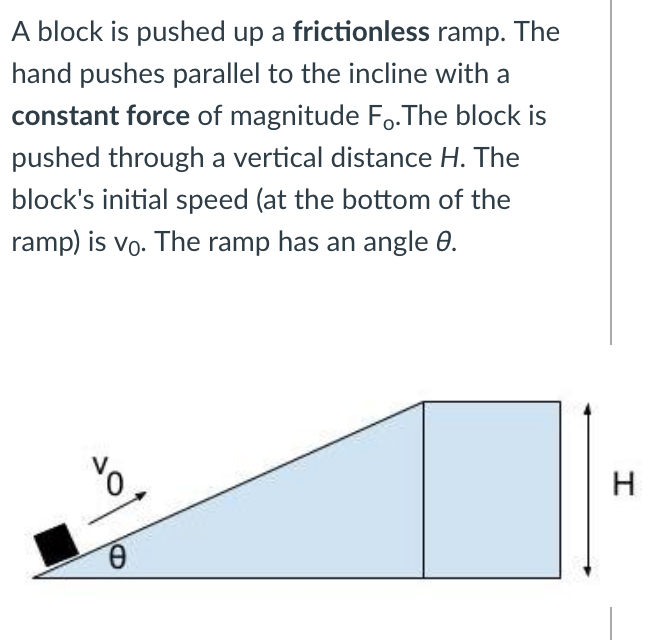
The work done by the hand on the block
Is positive
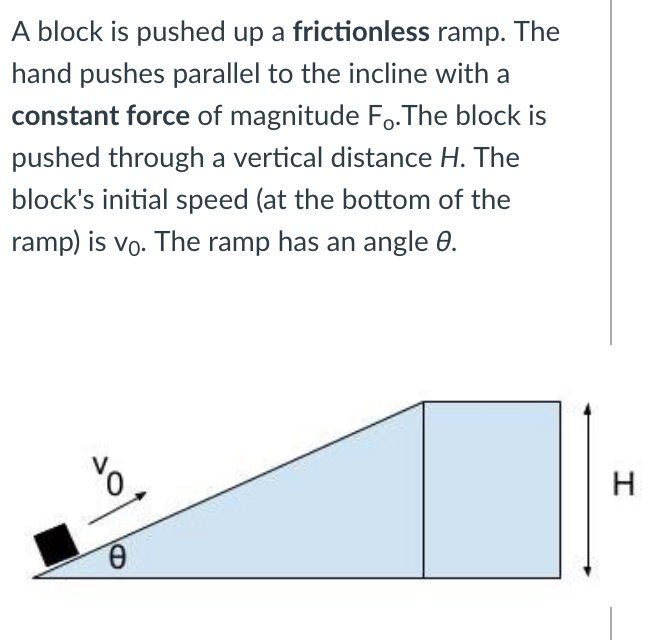
The work done by gravity on the block ____ depend on the choice of system.
Does not
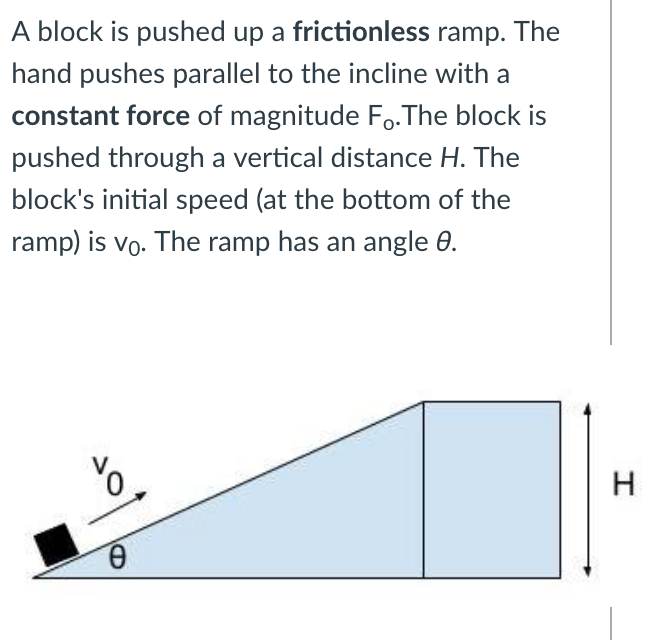
The work done by gravity on the block __________ if the system consists of the block only.
Is negative